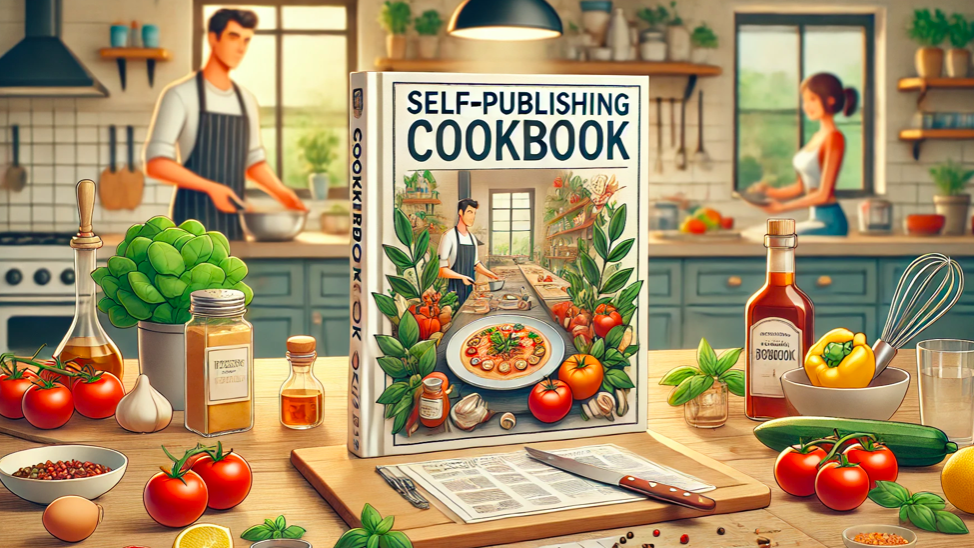Ever dreamed of taking complete control of your book’s destiny? Self-publishing puts you in the driver’s seat, offering unparalleled advantages over traditional publishing. Imagine speeding up the release, crafting your own marketing plan, and enjoying higher royalties—all while retaining full creative control.
Your Publishing Journey Awaits – Start NowFor cookbook authors, this freedom is especially valuable. In a market flooded with culinary content, thorough research, and a unique angle are essential to stand out. Success isn’t just about selling thousands of copies; even a modest number can be profitable with the right approach. Self-publishing is your chance to share your culinary vision with the world on your terms.
In this article, we’ll guide you through the essential steps to successfully self-publishing a cookbook.
Step 1: Identifying Your Target Audience
Knowing your target audience is crucial for a successful self-published cookbook, as it helps you tailor recipes, writing style, and presentation to their preferences and needs.
Are you writing for busy parents looking for quick meals?
Maybe you’re writing for health-conscious individuals?
Or are you writing for gourmet food enthusiasts?
Identifying your audience allows you to craft content that truly resonates, making your cookbook not only more appealing but also valuable. By tailoring your recipes and style, you create a connection with your readers, enhancing the book’s relevance and boosting its chances of success in the market.
Step 2: Research and Planning
Conducting thorough market research is a critical step in the self-publishing process. Start by exploring existing cookbooks to understand what’s already available and identify gaps in the market. Look at bestsellers, analyze their strengths, and note areas where they may fall short. Pay attention to their themes, recipe types, presentation styles, and target audiences. This research will help you gauge the competition and inform your approach.
Next, plan your cookbook’s unique angle or theme. In the realm of cookbook publishing, it’s essential to think about what sets your recipes apart and how you can offer something fresh and valuable to readers. Whether it’s a focus on regional cuisine, quick and easy meals, or health-conscious recipes, your theme should reflect your passion and expertise. A well-defined angle not only differentiates your cookbook from others but also attracts a specific audience, making your book more marketable and appealing.
Step 3: Writing and Formatting Recipes
A nice idea is to begin each recipe with a brief introduction that provides context, shares a personal story, or highlights key features of the dish. Use straightforward, easy-to-understand language, and list ingredients in the order they are used. Include precise measurements and specify any special preparation techniques or equipment required.
Formatting your recipes for readability and consistency is equally important. Use bullet points or numbered steps for instructions to make them easy to follow. Keep instructions short and to the point, breaking down complex processes into manageable steps. Ensure uniformity in your formatting, such as consistent use of headings, subheadings, and font styles.
Include visual elements like headings, bold text for important details, and spacing between sections to enhance clarity.
Step 4: Organizing Your Cookbook
Organizing your cookbook is key to creating a seamless and enjoyable experience for your readers. Start by arranging your chapters and sections in a logical order that suits the type of cookbook you’re creating. Common divisions include appetizers, main courses, sides, desserts, and beverages. Within each chapter, you can further break down the content into subcategories like quick meals, vegetarian dishes, or holiday specialties.
Don’t forget to include special sections for unique themes or dietary needs, like gluten-free or low-carb options, to cater to a broader audience. A well-organized cookbook not only makes it user-friendly but also adds to its overall appeal, ensuring readers can effortlessly navigate and enjoy your culinary creations.
Step 5: Designing Your Cookbook
Designing your cookbook involves creating a visually cohesive and appealing layout that enhances the reader’s experience. Working with a graphic designer can significantly elevate the overall look and feel of your book. A professional designer can help you create an eye-catching cover and an intuitive layout that guides readers smoothly through your recipes. They will ensure that the design elements are consistent and that the visual presentation aligns with the theme of your cookbook.
When choosing fonts, colors, and styles, consider your cookbook’s theme and target audience. Select fonts that are easy to read, even in smaller sizes. For headings and titles, opt for fonts that add character but do not compromise readability. Choose a color palette that complements your food photography and reflects the mood you want to convey, whether it’s vibrant and lively or rustic and cozy.
Styles should be consistent throughout the book, from the cover to the interior pages. Consistent design elements, such as chapter headings, borders, and icons, help create a professional and polished look.
Step 6: Photography and Visual Content
Eye-catching food photography is essential for making your cookbook visually appealing and irresistible. Beautiful images bring your recipes to life, showcasing the flavors, textures, and aromas in a way that entices readers and potential buyers. They elevate your cookbook, making it not just a collection of recipes but an experience to savor.
If you choose to photograph your dishes yourself, invest in a good camera and lighting equipment. Natural light is often the best option, so shoot near a window or outdoors. Pay attention to composition, using props and backgrounds that complement your dishes without overshadowing them. Experiment with angles and close-ups to highlight key features of the food.
Alternatively, hiring a professional food photographer ensures top-quality images. A professional will have the expertise to capture your dishes perfectly, allowing you to focus on other aspects of your cookbook.
Your Publishing Journey Awaits – Start NowWhether you take the photos yourself or hire a professional, high-quality visuals are essential for creating an attractive and engaging cookbook.
Step 7: Editing and Proofreading
Editing and proofreading your cookbook is one of the most essential steps before publication. Errors in recipes, measurements, or instructions can frustrate readers and undermine their trust in your book. Meticulous editing helps catch these mistakes, improving the clarity and accuracy of your content. Proofreading ensures your text is free of grammatical and typographical errors.
Hiring professional editors is often worthwhile investment, providing an expert eye to refine your work. Editors bring objectivity and experience, helping to enhance the readability and flow of your cookbook.
Step 8: Self-Publishing Your Cookbook!
It is important that you choose a self-publishing service that suits your needs. Ask yourself questions like:
Are you a first time self-publisher? Do you only need certain services? Are you just looking for a platform to publish your book on? Or do you want a publisher that offers essential services as well as publication?
Amazon KDP is a great choice if you’re looking to publish quickly, with the potential to have your book available within 24 hours. However, they don’t provide additional essential services, making them more suitable for experienced publishers. It’s also a great distribution channel, as your book is immediately available on all Amazon websites.
Another excellent option is Reedsy, a marketplace offering a range of high-quality publishing services, from editing and formatting to cover design and marketing. It’s ideal if you need support with specific aspects of the publishing process. Reedsy connects you with top industry professionals.
If you’re looking for the full publishing package from start to finish. BookBaby and Spines stand out as top notch options. They both offer everything from editing and cover design to marketing and distribution as well as 100% royalties They both also offer global distribution on channels like AMazon and Barnes&Noble.
Spines stands out for their innovative and transparent platform where you can easily follow your books process. Spines uses a combination of publishing experts as well as advanced technology, meaning they trun your manuscript into a published book in less than 30 days.
When choosing a publishing platform, keep these main factors in mind:
- Distribution Reach: How widely will your book be available?
- Print Quality: Essential for cookbooks with color photos and illustrations.
- Cost: Consider printing and distribution expenses, as well as additional services like ISBNs and marketing.
- Ease of Use: The platform should be user-friendly for uploading and formatting.
- Book Types: Ensure support for your desired format (eBook, paperback, hardcover).
- Royalties and Revenue Share: Look at how much you’ll earn from each sale.
Step 9: Formatting for Print and Digital
If you’ve chosen a publishing servies that deos this for you, then you can brush over this section!
Print formatting focuses on layout, margins, and high-resolution images to ensure quality on physical pages. Additionally, consider the cost implications of printing the entire book in full color versus black and white, as this can significantly impact the selling price and potential royalties.
Digital formatting, on the other hand, requires a responsive design that adjusts to various screen sizes and devices, with considerations for interactive elements like hyperlinks.
To ensure compatibility across formats, use tools that support both print and digital outputs, such as Adobe InDesign or Scrivener. Maintain consistent styles, fonts, and image placements, and validate that the eBook version is user-friendly on different e-readers.
Step 10: Pricing Your Cookbook
Pricing your cookbook involves balancing profitability with market competitiveness. Consider factors like production costs, including printing and distribution, and the royalties or fees associated with your chosen self-publishing service. Research the pricing of similar cookbooks to understand the market rates.
Evaluate your book’s unique value proposition—such as exclusive recipes, high-quality photography, or special themes—and price it accordingly. Setting a competitive price helps attract readers while ensuring it covers your costs and yields a profit. Offering various formats (eBook, paperback, hardcover) at different price points can also appeal to a broader audience, maximizing your sales potential.
Step 11: Printing Options and Distribution Channels
Exploring different printing options is crucial for managing costs and meeting your cookbook’s demand. Print-on-demand (POD) services, such as Spines, Amazon KDP, and BookBaby, allow you to print copies as orders come in, minimizing upfront costs and storage needs. POD is ideal for small initial runs and testing the market. For those looking to enhance quality and boost sales, professional printing services offer better design, formatting, and distribution.
Bulk printing can significantly reduce the per-unit cost but requires a larger upfront investment and storage space. This option suits those anticipating high demand or planning to sell at events. Assess your budget, sales projections, and storage capacity to choose the best printing option for your needs.
Distribution and sales channels are equally important for reaching your audience. Online platforms like Amazon, Barnes & Noble, and your own website provide broad reach and convenience, handling transactions and shipping to facilitate global sales. Most publishers offer distribution when your book is published, but it is essential to double check.
Offline channels include local bookstores, cooking schools, farmers’ markets, and culinary events, where you can sell directly to readers. Partnering with local retailers and attending events helps build community connections and boost visibility.
Step 12: Marketing and Promotion
Effective marketing and promotion are key to the success of your self-published cookbook. Start by developing a comprehensive marketing plan that outlines your target audience, key selling points, and promotional strategies.
Leverage social media platforms like Instagram, Facebook, and Pinterest to showcase your recipes and engage with potential readers. Share high-quality photos, behind-the-scenes content, and cooking tips to attract followers and build a community around your cookbook. Online platforms like Amazon play a significant role in driving book sales, so ensure your marketing strategy includes a strong presence there.
Your Publishing Journey Awaits – Start NowBlogs and food bloggers are powerful tools for promotion. Reach out to popular food bloggers and offer them a review copy of your cookbook in exchange for a review or feature post. Guest blogging on related sites can also help you reach a broader audience. Additionally, consider running contests or giveaways to generate excitement and encourage word-of-mouth promotion.
Bringing Your Culinary Vision to Life
Self-publishing a cookbook is an exciting journey that requires careful planning, from recipe development and platform selection to thoughtful design and strategic marketing. By following these steps, you can create a professional and captivating cookbook that showcases your unique flavors and stories. Start your journey today, and share your culinary creations with the world. Your recipes have the power to inspire and delight eager readers, so take the first step and let your culinary vision come to life!








